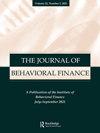分析师建议与媒体情绪:驱动投资者交易行为的补充还是替代?
IF 1.7
3区 经济学
Q3 BUSINESS, FINANCE
引用次数: 0
摘要
摘要本文从注意力吸引理论的角度研究了金融分析师推荐与新闻情绪之间的关系。具体来说,吸引注意力不应该足以解释媒体报道对投资决策的影响,因为投资者对犯错误持谨慎态度,并预期未来的损失会带来遗憾。我们的案例研究涉及一个报道二手信息和分析师建议的专栏。一旦该专栏不再报道分析师的建议,我们假设投资者也会评估该专栏的人气,以确保他们不会犯下代价高昂的错误。异常收益的事件研究和多变量分析表明,对于有明确分析师推荐的栏目,注意力吸引机制对买入决策有指导作用,而对卖出决策没有影响。在没有明确推荐的情况下,当市场情绪高度乐观时,投资者会将专栏的内容转化为隐含的推荐,引导他们做出购买决定。关键词:行为金融投资决策注意力吸引预期后悔分析主题分类代码:G40G110披露声明作者报告无竞争利益需要申报注1关于媒体对金融市场的影响,请参见Tetlock (Citation2015)。要探索市场对分析师建议在印刷媒体上传播的反应的文献,请参考Cervellati, Ferretti和Pattitoni (Citation2014)的综述散户投资者倾向于集中购买那些随后表现不佳的引人注目的股票(Barber, Lin, and Odean Citation2023)欧洲法院(European Court of Justice)重新审视了市场滥用问题,特别关注记者披露内幕信息的行为。在法院审理的案件(案件C-302/20)中,一名记者在《每日邮报》网站上发表了两篇文章,报道了有关公开收购hermes (LVMH旗下)和Maurel&Prom股票的传言。这名记者被法国金融市场监管局(autorit本文章由计算机程序翻译,如有差异,请以英文原文为准。
Analysts’ Recommendations and Press Sentiment: Complementary or Alternative to Drive Investors’ Trading Behavior?
AbstractThis paper focuses on the relationship between financial analysts’ recommendations and press sentiment from the perspective of the attention-grabbing theory. Specifically, attention-grabbing should not be enough to explain the effect that media coverage has on investment decisions, since investors are wary of making a mistake and anticipate the regret of a future loss. Our case study pertains to a column reporting on secondhand information and analysts’ recommendations. Once the column did not report the analysts’ advice anymore, we hypothesized investors also assess the sentiment of the column to make sure they are not making a costly mistake. Event studies on abnormal returns and multivariate analyses show that for columns with explicit analysts’ recommendations the attention-grabbing mechanism directs buying decisions while has no influences on selling decision. In the absence of explicit recommendations, investors transform the columns’ content into implicit recommendations leading their buying decisions when the sentiment is highly positive.Keywords: Behavioral financeinvestment decisionsattention grabbinganticipated regretsentiment analysisSubject classification codes: G40G110 Disclosure statementThe authors report there are no competing interests to declare.Notes1 For insights into the influence of media on financial markets, refer to Tetlock (Citation2015). To explore the literature on market reactions to the dissemination of analysts' recommendations in print media, consult the review by Cervellati, Ferretti, and Pattitoni (Citation2014).2 Retail investors tend to concentrate their purchases on attention-grabbing stocks that subsequently underperform (Barber, Lin, and Odean Citation2023).3 The European Court of Justice has revisited the issue of market abuse, specifically focusing on the disclosure of inside information by a journalist. In the case brought before the Court of Justice (Case C-302/20), a journalist published two articles on the Daily Mail website, reporting rumors about the filing of public offers to purchase shares of Hermès (by LVMH) and Maurel&Prom. The journalist was fined by the Autorité des marchés financiers (the French Financial Market Supervisory Authority) for disclosing the imminent publication of these articles, which was deemed as transmitting 'inside information'.4 Columns covering companies listed on foreign exchanges or companies with a short listing history (less than 130 trading days before the publishing date), as well as columns with incomplete data or mentioning more than one company, were excluded from the sample. Additionally, columns that were distributed with a delay due to a strike or columns for which the file could not be found in the newspaper's electronic database were also excluded from the analysis.5 Until 2010, all columns include a section presenting a list of analysts' recommendations. To establish a consensus recommendation, each recommendation is assigned a score based on a five-point rating scale: buy = 2, overweight = 1, hold/neutral = 0, underweight = -1, sell = -2. The average score and the modal score are calculated. If the average score is ≥ 0.8, or if the average score is ≥ 0.5 and the modal score is ≥ 1, the column is attributed a Positive Rating. Following the approach of Cervellati, Ferretti, and Pattitoni (Citation2014), neutral and negative ratings (underweight or sell) are grouped together. From 2011 to 2014, when analysts' recommendations are reported, they are presented in a condensed format using a pie chart displaying the buy, hold, and sell percentages. To convert the chart into a score, a three-point rating scale is used: buy = 2, hold = 0, sell = -2. The weighted average score is then calculated. If the average score is ≥ 0.8, the column is attributed a Positive Rating.6 The NRC lexicon is a comprehensive resource that consists of a list of words along with their associations with eight specific emotions and two sentiments: negative and positive. The lexicon provides sentiment values for a wide range of 13,901 words and covers translations for over 40 different languages, including Italian (see https://saifmohammad.com/WebPages/NRC-Emotion-Lexicon.htm).
求助全文
通过发布文献求助,成功后即可免费获取论文全文。
去求助
来源期刊

Journal of Behavioral Finance
Multiple-
CiteScore
4.60
自引率
10.50%
发文量
34
期刊介绍:
In Journal of Behavioral Finance , leaders in many fields are brought together to address the implications of current work on individual and group emotion, cognition, and action for the behavior of investment markets. They include specialists in personality, social, and clinical psychology; psychiatry; organizational behavior; accounting; marketing; sociology; anthropology; behavioral economics; finance; and the multidisciplinary study of judgment and decision making. The journal will foster debate among groups who have keen insights into the behavioral patterns of markets but have not historically published in the more traditional financial and economic journals. Further, it will stimulate new interdisciplinary research and theory that will build a body of knowledge about the psychological influences on investment market fluctuations. The most obvious benefit will be a new understanding of investment markets that can greatly improve investment decision making. Another benefit will be the opportunity for behavioral scientists to expand the scope of their studies via the use of the enormous databases that document behavior in investment markets.
 求助内容:
求助内容: 应助结果提醒方式:
应助结果提醒方式:


